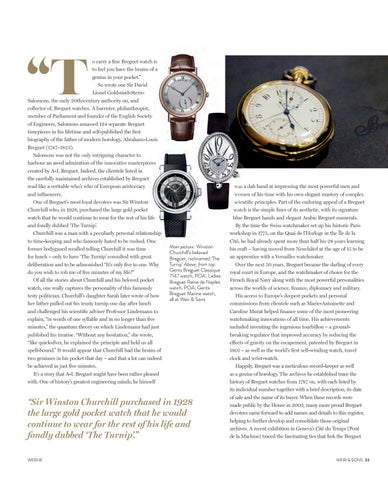“T
o carry a fine Breguet watch is to feel you have the brains of a genius in your pocket.” So wrote one Sir David Lionel Goldsmid-SternSalomons, the early 20th-century authority on, and collector of, Breguet watches. A barrister, philanthropist, member of Parliament and founder of the English Society of Engineers, Salomons amassed 124 separate Breguet timepieces in his lifetime and self-published the first biography of the father of modern horology, Abraham-Louis Breguet (1747–1823). Salomons was not the only intriguing character to harbour an awed admiration of the innovative masterpieces created by A-L Breguet. Indeed, the clientele listed in the carefully maintained archives established by Breguet read like a veritable who’s who of European aristocracy and influencers. One of Breguet’s most loyal devotees was Sir Winston Churchill who, in 1928, purchased the large gold pocket watch that he would continue to wear for the rest of his life and fondly dubbed ‘The Turnip’. Churchill was a man with a peculiarly personal relationship to time-keeping and who famously hated to be rushed. One former bodyguard recalled telling Churchill it was time for lunch – only to have ‘The Turnip’ consulted with great deliberation and to be admonished “It’s only five to one. Why do you wish to rob me of five minutes of my life?” Of all the stories about Churchill and his beloved pocket watch, one really captures the personality of this famously testy politician. Churchill’s daughter Sarah later wrote of how her father pulled out his trusty turnip one day after lunch and challenged his scientific adviser Professor Lindemann to explain, “in words of one syllable and in no longer than five minutes,” the quantum theory on which Lindemann had just published his treatise. “Without any hesitation,” she wrote, “like quicksilver, he explained the principle and held us all spell-bound.” It would appear that Churchill had the brains of two geniuses in his pocket that day – and that a lot can indeed be achieved in just five minutes. It’s a story that A-L Breguet might have been rather pleased with. One of history’s greatest engineering minds, he himself
Main picture: Winston Churchill’s beloved Breguet, nicknamed ‘The Turnip’ Above, from top: Gents Breguet Classique 7147 watch, POA; Ladies Breguet Reine de Naples watch, POA; Gents Breguet Marine watch, all at Weir & Sons
“Sir Winston Churchill purchased in 1928 the large gold pocket watch that he would continue to wear for the rest of his life and fondly dubbed ‘The Turnip’.” WEIR.IE
was a dab hand at impressing the most powerful men and women of his time with his own elegant mastery of complex scientific principles. Part of the enduring appeal of a Breguet watch is the simple lines of its aesthetic, with its signature blue Breguet hands and elegant Arabic Breguet numerals. By the time the Swiss watchmaker set up his historic Paris workshop in 1775, on the Quai de l’Horloge in the Île de la Cité, he had already spent more than half his 28 years learning his craft – having moved from Neuchâtel at the age of 15 to be an apprentice with a Versailles watchmaker. Over the next 50 years, Breguet became the darling of every royal court in Europe, and the watchmaker of choice for the French Royal Navy along with the most powerful personalities across the worlds of science, finance, diplomacy and military. His access to Europe’s deepest pockets and personal commissions from clientele such as Marie-Antoinette and Caroline Murat helped finance some of the most pioneering watchmaking innovations of all time. His achievements included inventing the ingenious tourbillon – a groundbreaking regulator that improved accuracy by reducing the effects of gravity on the escapement, patented by Breguet in 1801 – as well as the world’s first self-winding watch, travel clock and wrist-watch. Happily, Breguet was a meticulous record-keeper as well as a genius of horology. The archives he established trace the history of Breguet watches from 1787 on, with each listed by its individual number together with a brief description, its date of sale and the name of its buyer. When these records were made public by the House in 2003, many more proud Breguet devotees came forward to add names and details to this register, helping to further develop and consolidate those original archives. A recent exhibition in Geneva’s Cité du Temps (Pont de la Machine) traced the fascinating ties that link the Breguet
WEIR & SONS 33
